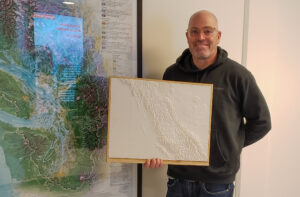Makerspace at the intersection of innovation and preservation
Students, faculty and staff are creating tangible goods through 3D printing
By TUAN TRAN
Makerspace offers Langara solutions for hard-to-find replacement parts as well as student and faculty projects: it will make them.
“The Makerspace is a resource for all of Langara,” said Philip Robbins, coordinator of the department. “We have more capability in this room than the early factories in the Industrial Revolution had.”
Makerspace is a creative work area at Langara that uses technology like laser cutters, plasma cutters, 3D printers and sewing machines for the creation of different products. The department also promotes faculty development by encouraging the integration of new technologies into their teaching curriculum.
A modern approach at fixing old stuff
Older buildings at Langara require regular maintenance, but certain necessary parts are no longer accessible.
Don Gillard, Makerspace’s technician, said the process of replacing a part starts with a person coming in with a problem and shifts to figuring out how to produce an item. Production involves sketching the design and recording the dimensions, followed by creating it in a 3D program. If the item is intended for 3D printing, it is output through one of the available 3D printers.
“Most of the stuff I do here, you can’t get parts for it,” Gillard said. He said that parts like the end caps for the doors and windows for the aging Langara buildings are no longer available on the market, but they can still be 3D printed at Makerspace.
Instructors have also used the Makerspace to create good quality replacement parts for instruments they use around their departments at a fraction of the cost.
Mapping Canada
Andrew Egan, a geography instructor in the environmental studies program, is using Makerspace to produce a 3D-printed topographical map of Canada that will display geographic information.
Egan’s long-term project involves collaborating with his current and upcoming students to create individual 3D-printed square tiles that — when finalized — will combine to form a map of Canada. Egan hopes to have his project finished by 2026.
“[The map] is a whiteboard,” Egan said. “We can demonstrate the geological formations… population densities for all of Canada [or] differences in the agriculture or soil types.”
Egan involved his students in the project by allowing them to select tiles, learn to use the 3D printers, and print their chosen pieces.
“Part of what we want to do is we want to illustrate how we can use 3D printers in the field of geography,” Egan said. “This way all students are learning that 3D printing is not just for making little figurines or what have you, but you actually can have a slightly artistic and different, more practical form.”

Learning by doing
Former student Wai Yip Suen, an environmental studies major, expressed how Egan’s project has sparked enthusiasm within him for 3D printing.
“I saw 3D printing on YouTube before, but never touched or even printed something for myself,” he said.
Trying a 3D printer for the first time, Suen said how incredible it is to simply upload a 3D file and have it automatically print an object and using that object instead of just viewing it on a computer screen.
Egan said, “the idea is to use this project to introduce them to the Makerspace and give them a sense of comfort in using that technology and that equipment and the tools that exist there.”
VIDEO: Instructor Andrew Egan and his long-term project 3D printed at Langara’s Makerspace.


Comments are closed.